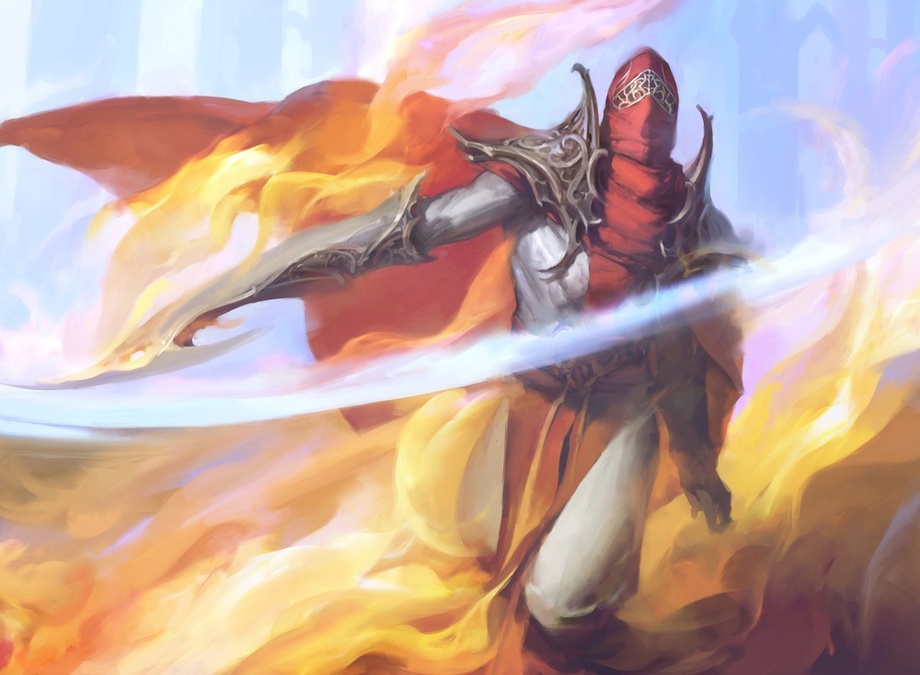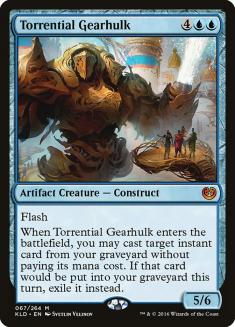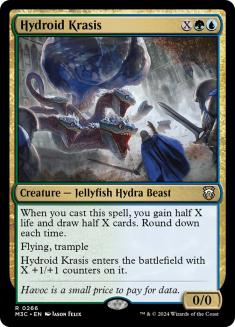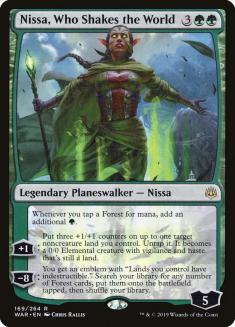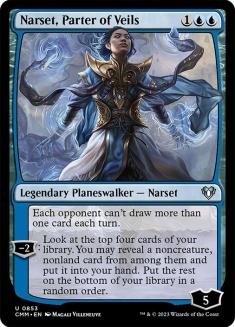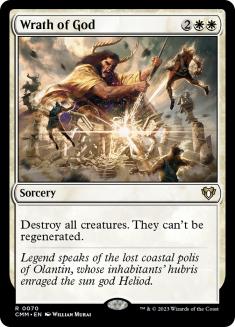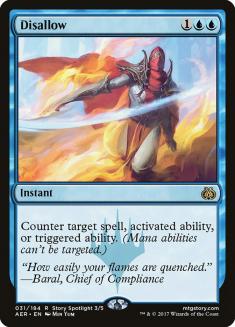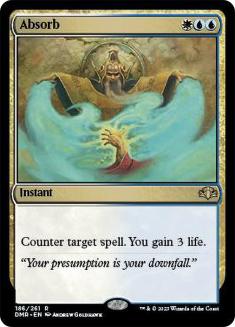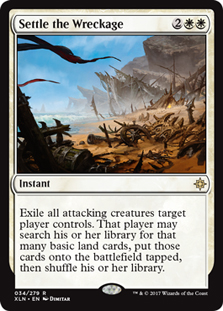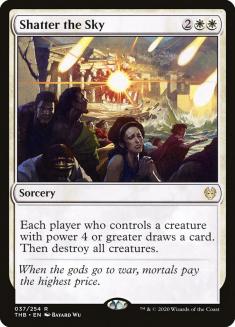In an erratic format, control struggles. The strength of control decks rests in their ability to identify the biggest threats of the format and then incorporate specific removal and win conditions that excel against them. If the card draw and mana fixing are passable, a format that has settled with a few decks to beat can be conquered. When there are a dozen different decks with unique threats in each, control is at its worst. This has been the case for older formats especially, which is why we do not see the glorious championships from control these days.
Modern is the format that comes to mind the most when analyzing control’s success. I have personally crushed a few tournaments with Azorius Control over the years; however, it was at times where the format was not in a great place. One example was at GP Richmond, where I finished 13-2: I played against Affinity seven times. Hitting my opponents with Wrath of God into Baneslayer Angel was good enough, but I also had a bunch of Stony Silence in the sideboard to seal the deal. Knowing what the best few decks are is advantageous to all archetypes; it’s just control happens to turn that advantage into dominance.
Control in Modern is currently in a good place, utilizing the power of Omnath, Locus of Creation and Uro, Titan of Nature’s Wrath to squash the other creature decks of the format. With the core of the deck strong against the bulk of the field, the unique disruption can be aimed at defeating Primeval Titan, making control a powerful contender. With control being alive and well in Modern and Standard, we look to recent Historic results to determine its viability there.
The SCG Tour Online $5K Kaldheim Championship Qualifier just wrapped up last weekend and the results were very promising for control enthusiasts like me. Last week I identified the power of Azorius Control, with an emphasis on Torrential Gearhulk. Although the giant Snapcaster Mage was not represented well in the Top 8, there were multiple high finishers who embraced the control playstyle with success. Some competitors went the reactive route, while others frequently tapped all their mana on their own turn. Each strategy has its pros and cons, but both are made possible by a format that has finally begun to settle on a few top decks.
Rakdos Sacrifice (along with other Sacrifice decks); Mono-Red Goblins; tap-out control/midrange Uro, Titan of Nature’s Wrath decks; and Azorius/Orzhov Auras (Lurrus) have clearly defined the Historic metagame. Most decks that are not on this list are aberrations, either in the fringe tiers are too weak to compete against the gauntlet listed above. This type of identifiable format is the perfect ecosystem for control players to craft their masterpiece.
There are many more Historic events to come, but the ones we have seen so far, focusing especially on the SCG Tour Online Satellites and Championship Qualifiers, have verified what we have suspected. Mono-Red Goblins and Rakdos Sacrifice dominate the aggressive lane; Uro, Titan of Nature’s Wrath makes tap-out control possible; and the Azorius/Orzhov Auras decks exist to throw a wrench in the traditional disruption gameplan.
Creatures (9)
Planeswalkers (4)
Lands (23)
Spells (24)

Four-Color Midrange won the SCG Tour Online $5K Kaldheim Championship Qualifier but I would argue that it’s a control deck by definition. Adding a couple of copies of Yasharn, Implacable Earth to Sultai does not constitute a shift to midrange, but instead an obvious boost to hitting vital land drops to fuel a massive X-spell.
Hydroid Krasis and Uro, Titan of Nature’s Wrath are the only other creatures in the Four-Color Midrange deck listed, accompanied by fifteen disruption spells. A deck with resilient card-draw creatures only, some planeswalkers, and this much disruption is a tap-out control deck in my book. Archetype definitions aside, this deck has proven itself one of the best decks of the format by a wide margin.
The sideboard has transformational components to push it even farther into the control realm. Shark Typhoon; counterspells; and Narset, Parter of Veils all help amplify the already strong control elements against the grindier decks of the format. These are especially used to target the mirror, preventing opponents from drawing additional cards and producing an uncounterable threat at instant speed.
The additional removal also assists Four-Color Midrange in changing gears, dropping enemy creatures while keeping the hand full using the hyper-efficient card advantage that is naturally present in the win conditions. The list and strategy here are not unique creations in Historic, but a dominant part of competitive play for the last year of Magic.
We have seen Sultai Control make a splash in Historic in past events. The core of the deck was the same, casting a couple of creatures that draw a bunch of cards and hit like a truck, all while firing off removal and Thoughtseize. It’s a mirror image of the problematic decks that roamed Standard for so long, even including Nissa, Who Shakes the World, which was considered the most broken element of the fractured format for a time. In Sultai (or Four-Color) Midrange, it remains the centerpiece, producing a ton of mana to deliver a Hydroid Krasis of monumental proportions.
This strategy cannot be beaten by traditional disruption, due to abilities of each of the win conditions in the deck. Yasharn awards two lands, Uro draws a card every time it sees the light of the battlefield, and Hydroid Krasis produces even if countered. With two of these having a pile of lifegain attached, aggro can forget about racing it as well. These are reasons why it was problematic in Standard and the same is carrying over to Historic. While we have Uro, we might as well utilize the incredible power before it’s inevitably removed.
Planeswalkers (6)
Lands (17)
Spells (37)

Azorius Control also made the Top 8 of the SCG Tour Online $5K Kaldheim Championship Qualifier. This is a more reactive version than what I prefer in Historic, with it rarely being forced to tap its mana in the main phase. The path to success for Lukas Honnay was paved by Teferi, Hero of Dominaria and Shark Typhoon. These two are the success criteria for a reactive Azorius Control deck. Narset and Wrath of God are the two spells that are non-negotiable, due to the metagame breakdown.
With it being a guarantee that Uro will be on the other side of the battlefield, Narset must be part of the Azorius Control gameplan. In my most recent version, I opted to have it in the sideboard due to the amount of aggressive decks that were running rampant on MTG Arena. Since this tournament was taken down by the powerful Simic elements of the format, Narset is back to a starter. The static ability is a lifesaver against any control/midrange deck moving forward in Historic.
Wrath of God is the end-all, be-all against Mono-Red Goblins and Rakdos Sacrifice. I understand that both of those decks have a level of resiliency against sweepers, but not enough to erase control as one of the top contenders of the format. If Wrath of God barely scratched some Goblins, then the discussion surrounding Azorius Control would be over. Control is only as good as its disruption. Luckily for Azorius Control, Wrath of God gets the job done with minimal support needed.
The rest of the deck fits the traditional mold of Azorius Control well. Grafdigger’s Cage in the maindeck does work against the top decks of the format. It’s nearly impossible to play a hate card in the maindeck in any format, unless the top decks are that obvious. In Historic, nearly every deck is trying to return cards to the battlefield or deploy them from the library. This allows for Azorius Control to have a great advantage over decks that have their card advantage engines tied to those zones of play.
The disruption played in this version of Azorius Control is strong and I agree with most card choices. The area where I break off just a bit is Absorb over Disallow. It is probably best to do a split between the two in order to have access to some lifegain while being able to answer a big Hydroid Krasis trigger as well. Absorb is the stronger card more often, but game losses can be avoided when you are able to Stifle the final breath out of a Four-Color Midrange opponent. Disallow also has saved my life against planeswalker ultimates and a large Shark Typhoon, both of which are big surprises to my opponents.
In this sideboard, Honnay looks to shut down his midrange/control opponents with a pile of blue disruption and the maximum amount of Narset. I agree with all the spells here being used, but I would drop the number just a bit. Toying with sideboarded games against the winning list, I struggle to bring in all the weapons listed while trying to keep in a Baffling End to handle resolved threats. I have found myself in trouble when assuming my Mystical Dispute will always find its way to a Hydroid Krasis or Narset will definitely be on the battlefield to prevent a returned Uro. Keeping in a couple of removal spells to prevent a loss to threats that have escaped is usually the correct call.
The rest of the sideboard fits the bill against scary red-based aggro decks, but I would like to add a Settle the Wreckage or two in order to handle Azorius/Orzhov Auras. The targeted removal is great and gets around indestructible nuisances, but protection from a color can also be a problem. Pressuring the opponent on Turn 2 with those, plus having an instant-speed spell that exiles all attackers as insurance, is where I want to be with Azorius Control. Settle the Wreckage is also a fine card against the red-based aggro decks, making it versatile enough to deserve a sideboard slot.
Creatures (1)
Planeswalkers (10)
Lands (24)
Spells (25)

Rory King’s Azorius Control deck is much more up my alley than Honnay’s. Both have their merits, but King uses the synergy between Gideon of the Trials and Pact of Negation to add a broken element to what is normally a fair deck. His version of Azorius Control looks very similar to mine, adding Disallow, The Birth of Meletis, Hieroglyphic Illumination, Essence Scatter, and Torrential Gearhulk to the traditional version.
The justifications to these deck choices are more in-depth in my article from last week, but there are a few changes that King made that I agree with. Hieroglyphic Illumination is the competitor to Glimmer of Genius and is likely a better move given the format as it is. Even though Glimmer of Genius provides quality cards at the same official mana cost, the cycling for one blue is a game changer. Hitting land drops, especially in a deck with 26 land and two The Birth of Meletis, is not automatic. Having Hieroglyphic Illumination provides additional opportunities for that while giving some late-game windows for card advantage.
With Hieroglyphic Illumination, Disallow, Essence Scatter, and Pact of Negation, Torrential Gearhulk is at full strength. I disagree with dropping the Torrential Gearhulk count from two to one for that reason. Objectively speaking, Hieroglyphic Illumination is not a powerful card on its own, but having the ability to recast it in the late-game made the one-mana cycler worth including.
The only other disagreement I have it mixing Shatter the Sky in with Wrath of God.
Shatter the Sky is a Standard staple because Wrath of God does not exist. I see the logic King had when making this split, giving himself an opportunity to draw a card off a Gideon of the Trials that is activated, or a lost Torrential Gearhulk. The amount of times this occurs does not offset the advantage opponents gain with their own four-power creatures. I respect the innovation here, trying to twist some more value from the sweepers, but I would not make that change.
The rest of King’s deck is great, especially the sideboard. Each card there makes perfect sense to me and he even had the foresight to keep Narset in the maindeck as a three-of. I predicted more players would push the aggro element of the format in the SCG Tour Online $5K Kaldheim Championship Qualifier, based on the Satellite data and MTG Arena metagame, but brave/skilled souls decided to crunch the competition with Uro.
Mono-Red Goblins is still the deck to beat, but Azorius Control can do that well with the stock elements. Narset is a required piece to solve the Hydroid Krasis / Uro puzzle for control, which King knew. Although he did not win the tournament, ninth place is a strong finish, combined with the sixth place that Honnay achieved.
This is some of the evidence that proves Azorius Control can easily contend with the best decks. If you accept my definition of a tap-out control deck, this tournament, and the ones to follow, will show the level of dominance that Teferi and Uro provide to the digital control users moving forward.

